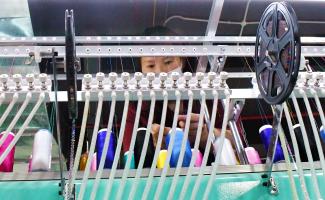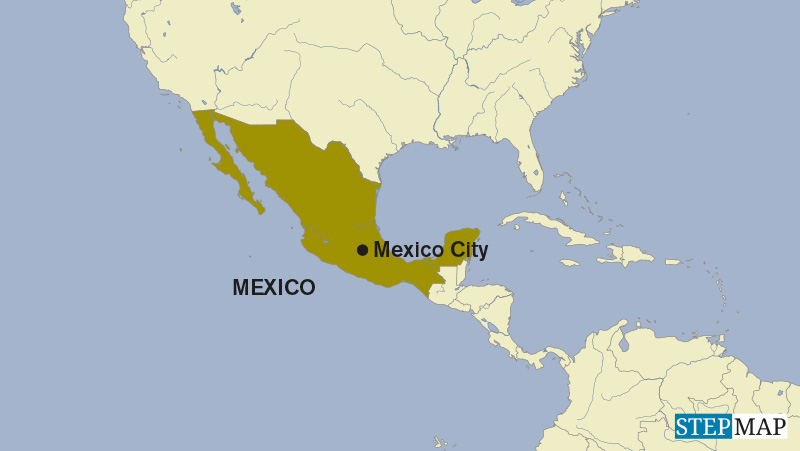Occupational health
Toxic substances in the life cycle of clothing

The textile and fashion industry is one of the biggest industries in the world. It is known for the intensive use of pesticides, water, energy and toxic chemicals. Poisonous emissions contaminate water, soil and air. The impact on our planet is enormous and results from the entire life cycle of textile products. Relevant issues include raw-material supply, production, delivery, retailing and disposal. Indeed, textile waste problems abound – especially in poorer world regions.
Clothing consumption has increased in recent years. That has not only led to more production, but also to a dramatic increase in textile waste worldwide. According to Value Village, a global reuse chain, almost 12 million metric tons of clothing and textiles accumulate in landfills each year, of which 95 % could be reused or recycled. Many countries do not have the required capacities, however, so poor inappropriate waste management results in the emission of pollutants from the burning of textile waste or toxic substances leaking from disintegrating garbage in landfills. Textile-waste problems are most acute in disadvantaged regions, as used clothing exported from high-income countries to low-income countries accumulates in the developing world.
On the other hand, up to 90 % of clothing is produced in developing countries, where labour and safety standards are often not respected or even do not exist at all. Environmental legislation tends to be similarly dysfunctional. Social problems are well known, and they persist even though many companies claim to adhere to high standards. Most of the workers are women who did not get a good education and fear losing their jobs. Some of the many serious grievances are:
- low wages,
- long working hours,
- unpaid over-time work,
- no paid leave,
- exploitation of children,
- lack of career opportunities and
- sexual harassment at work.
Gender-specific health risks
Moreover, occupational safety typically does not get adequate attention in the textile and garment sector. Health hazards in the sector affect both men and women, but some are gender-specific, including breast cancer, spontaneously aborted pregnancies and hypertensive disorders during pregnancy.
Adding to the problems, the women often do not associate their health issues with toxic chemical exposure. They do not even know what chemicals they are exposed to and why they could cause them harm. More often than not, employers leave their staff in the dark, and many do not run in-house health services that might be of help when needed (for chemicals in general, see Hans-Christian Stolzenberg on www.dandc.eu).
Indeed, up to 40,000 synthetic chemicals are applied in the entire supply chain, starting with raw-material production. Some are carcinogenic, mutagenic and endocrine-disrupting. Hardly a stage in textile and garments production does not rely on chemicals. The sheer multitude makes safe and environmentally sound management a huge challenge.
For every kilogramme of fabric, an estimated 580 grammes of various substances is used on average. Dyeing alone usually involves more than 1600 different chemicals, including toxic ones such as formaldehyde, phthalates and perfluorinated substances. They are used because they make materials resistant to stains, oil and water. Other chemicals provide clothing with other features, such as wrinkle-resistance.
Some of them are dangerous – for example carbon disulphide. It is used to spin cellulose into viscose fibres, although it causes significant health risks. It can lead to coronary heart disease, psychophysiological and central nervous system effects or retinal angiopathy, for instance. Studies have shown that women who are chronically exposed to carbon disulphide may suffer menstrual irregularities, early menopause and other conditions linked to hormonal disruption.
Lethal history
In his book “Fake Silk” (2016), Paul Blanc of the University of California, assessed a “lethal history” and noted that multinational corporations are aware of the dangers. Nonetheless, huge profits prevailed over common sense and safety requirements. Blanc wrote that viscose fabric continued to be “greenwashed” as an eco-friendly product, even though it cannot be produced without using toxic substances. To ensure the health of workers in the viscose industry, rigorous environmental and social standards must be developed.
Another material common in the textile industry is polyester. It is made from plastic that contains various toxic additives which give the material the desired properties. It is the most used fibre worldwide and makes up about 60 % of clothing composition. There are different types, and the most common one is PET (polyethylene terephthalate). It is used in clothing and packages.
Various toxic chemicals are used in the production of polyester. For example, antimony trioxide, a catalyst in producing polyester fibres, is a carcinogen. It potentially harms the health of workers who are exposed to it in the production process. However, antimony pollution can affect other persons as well. For example, waste water from textile factories regularly contains this substance and contaminates ground water as well as local sources. Even consumers are at risk to some extent. Research has shown that polyester textile samples designed for contact with human skin release antimony (for chemicals-related consumer risks, see my previous essay on www.dandc.eu).
Another serious problem with polyester and many other plastic-derived fibres is the release of microplastics. Microplastics have been found in drinking water, beer and various foods, including salt, honey and sugar. One source of pollution is the discharge from washing machines. Oceans, Glaciers and even arctic ice are polluted with microplastics (see Sabine Balk on www.dandc.eu).
Make the industry sustainable
Making the textiles and garment industry sustainable is a huge challenge. The industry must minimise and ultimately eliminate toxic substances – both from the supply chain and its products. Human health and environmental safety matter more than profits. Responsible manufacturers pay special attention to these issues.
There actually are economic incentives for doing so too. One example is the Blue Angel label. The requirements for using it are based on EU and German chemicals legislation, which stringently restricts the use of heavy metals and prohibits the application of entire groups of toxic substances, such as chloroalkanes and perfluorinated chemicals or alkylphenol ethoxylates. Moreover, it rules out the use of nanomaterial in the production of leather and leather materials.
Another incentive is the IVN Leather Standard. It was introduced by the Berlin-based International Association of Natural Textile Industry (IVN – Internationaler Verband der Naturtextilwirtschaft). To get certification, a manufacturer must meet requirements throughout the production processes. The Standard contains a detailed list of banned substances such as endocrine disruptors, heavy metals and biocides. It also bans substances which are considered worrisome but have not yet been band in the context of REACH, the EU legislation regarding the “registration, evaluation, authorisation and restriction of chemicals” (see Katja Dombrowski on www.dandc.eu).
Of course, workers and consumers must be protected better around the world, and not only in Europe. No doubt, the textile and garments industry needs strict environmental standards everywhere. Occupational health and safety must be ensured at all levels – from raw-material supply to waste management.
Insufficient flow of information
According to Brigitte Zietlow from Umweltbundesamt (UBA – Germany’s environmental protection agency), insufficient information exchange within the supply chain compounds the problems. She says that “brands often really don’t know their suppliers”. They know what companies they source their goods from, but often have only a vague idea of who figures at what stage in their supply chains.
The expert from the government agency insists that “sustainable textiles” means that the whole process, from fibre production (including the growing of the cotton) to the ready-made process, must be done in environmentally sound and socially equitable circumstances. One implication is that up-to-date technology must be used.
Clearly, the textile industry has many reasons to focus on sustainability, including environmental protection, social justice, economic stability and related processes such as textile waste recycling. Chemical hazards deserve more attention than they have attracted so far.
References
Blanc, P., 2016: Fake silk – The lethal history of viscose rayon. Yale University Press.
Interview with Brigitte Zietlow:
https://sustainfashion.info/de/interview-mit-brigitte-zietlow-umweltbundesamt-uba/
Olga Speranskaya is one of two co-directors of the international non-governmental organisation Health and Environment Justice Support (HEJSupport). Its offices are in Dachau, Moscow and Ottawa.
olga.speranskaya@hej-support.org












